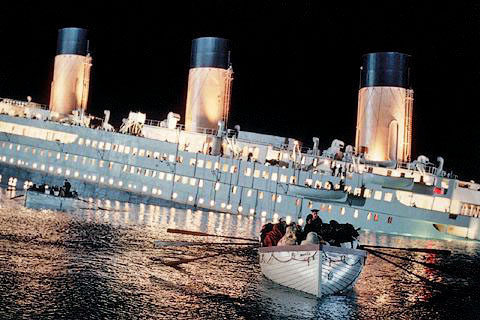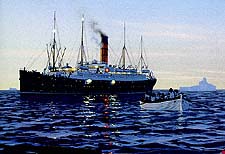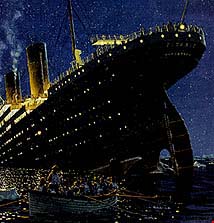 |
 |
On the maiden voyage, the Titanic
carried enough food to feed a small town for several months, for example:
998kg of coffee
34,019kg of meat
35,000 fresh eggs
36,000 apples
36,000 oranges
16,000 lemons
6,820l of milk
2,722 kg of butter
794kg of ice-cream
40.6 tonnes of potatoes
800 bundles of asparagus
1,000 bottles of wine
15,000 bottles of ale and
stout
It also carried one Renault auto mobile.
On April 11, in Queenstown, Ireland the final passengers boarded. Since no dock could accommodate her, they had to be ferried to her.
The Titanic received a total
of nine ice warnings but
still continued to steam full speed ahead, at 44km/hr (22 knots).
 |
The Titanic grazes the side of the iceberg, puncturing holes into its lower decks. Cargo rooms 1-5 and boiler room6 flooded from iceberg damage. The bow started to sink, tilting the ship forward.
By 12.45am the first lifeboat
no. 7 was lowered. Despite a capacity of 65 people and being short of lifeboats
for more than half of the passengers, it was launched into the sea with
only a capacity of 28. This was because many of the officers were skeptical
of the amount of weight the boats could hold, as they were not told of
the rigorous testing that the boats went through.
 |
Even when they were on the lifeboats, many passengers were skeptical about the Titanic sinking; this was partly why many of them did not want to board the lifeboats in the first place.
The ship continues to flood, causing it to tilt further until it appears to be sinking almost vertically into the ocean. The stern is unable to take the pressure of being suspended so high up in the air and thus the whole ship breaks into two parts.
The bow continues to plunge into the ocean and slowly drags the stern down. At 2.20am on April 15, the Titanic sinks, approximately 21.7km east-southeast of the position from where her distress call was first transmitted.
 |